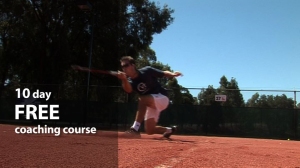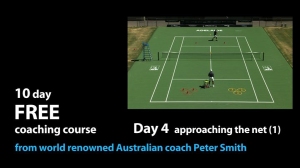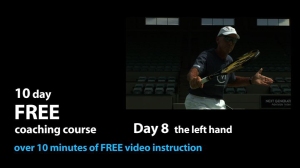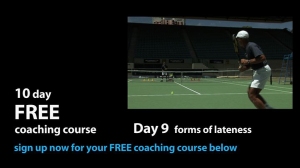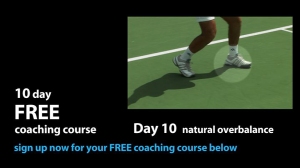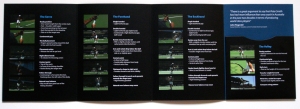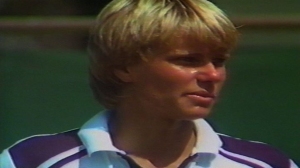WATCH AND LEARN FROM THE GREATS OF THE MODERN GAME
Written by: Peter Smith
Featured in ACE Magazine – Issue 137 / November 2008

ACE Magazine November 2008
If you are like me, you probably have a tendency to watch what is almost a daily smorgasbord of sensational tennis either live or on television, purely for its entertainment value. It can be such an adrenalin rush to watch the energy and artistry of the likes of Federer, Nadal and the Williams sisters and the list goes on.
Unfortunately this approach, although hugely enjoyable, to a large degree wastes a potentially valuable learning experience. So I am trying hard to develop new skills of “watching and learning from the Pros”.
Just to make analysis easier, I have divided the game into 4 broad areas: Technical, Tactical, Mental and Physical
Under these headings it may sometimes be more productive to make a general observation or alternatively there may be some very specific learning point that catches your eye.
So, let’s have a go as I share with you a quick glance at some of the superstars of world tennis! Just a hint: see if you can differentiate between the “must-do things” that make all good players good and the additional really creative things that maybe make a genius but are probably too ambitious to be attempted by the average club player.

Roger Federer
ROGER FEDERER
Technical
Beautiful classic technique across a full range of strokes – made achievable by using quite conventional grips (not extreme)
Hits each stroke with apparent ease – everything is calm & smooth – never appears to force a shot even when his intention is clearly to hit a “big winner”
Even in his early junior days, Roger had the reputation of being capable of producing amazing racquet head speed – the best example is probably his forehand groundstroke which is arguably the most dangerous stroke in men’s tennis.
Tactical
Very few if any other players possess Roger’s total all-court game – this is made possible by not only having all the standard strokes but having a number of additional variations to each of these as well. The outcome is an ability to play at the highest level from any area of the court, on any court surface & against any style of opponent.
Mental
Has an aura of great self belief which eminates from having almost total confidence in every area of the game – opponents feel this as well, even before walking onto the court
Roger is clearly quite intimidating in his own quiet way – what an advantage!
Physical
A gifted elastic athlete – this allows Roger to make very subtle changes to standard strokes – great variation of spin
Excellent perception in addition to being deceptively incredibly quick
Always beautifully balanced leading to superb preparation on almost every stroke – rarely hurried

Rafael Nadal
RAFAEL NADAL
Technical
Renowned as having the “heaviest” groundstrokes in the game (quite extreme grips) – due to his physical strength is capable of producing extraordinary topspin without losing penetration through the court
Wonderful example for all aspiring players as he continues to strengthen every area of his game – the heavy topspin is now complimented with a quality serve, a variety of slices & very competent volleying – a genuine all-court game!
Tactical
The basis of Rafael’s game is all-court soundness, as he seems to have an answer for every ball that comes into his court.
He also has an amazing ability to create difficulty at the other end of the court.
Perhaps the best defensive player in the world – brilliantly complimented with great offensive options
Mental
Possesses extreme competitiveness – just seems to love the contest
His mental toughness appears to allow him to actually “will” points.
Plays the big points incredibly well converting a high percentage of break points when receiving while demonstrating an enormous capacity to defend break points when serving
Quite superstitious – famous for the thoroughness of his “routines” when serving, receiving or even changing ends (check out the drink bottles)
Physical
What an athlete! Extraordinarily explosive, he has amazing court coverage tracking down almost every ball no matter how difficult, always trying to make the opponent play one extra shot – an energy machine!
Seems to possess endless stamina, rarely showing signs of fatigue – quite amazing considering his incredibly demanding match schedule
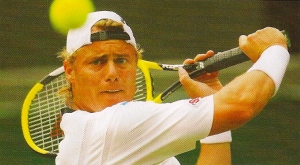
Lleyton Hewitt
LLEYTON HEWITT
Technical
The standout feature of Lleyton’s game is his overall soundness. He has a proven ability to play on all surfaces & a Grand Slam Doubles’ title is testimony to his all-court game.
His backhand groundstroke is respected for its consistency & range of variations while his volleying, particularly through the short corners, is often underestimated.
Tactical
Not as big as many of the leading players, Lleyton has made a feature of some of the more subtle areas of the game. A brilliant, creative counter-puncher, he has turned lobbing, returning serve & hitting passing shots into an art form.
Mental
Exceptionally competitive, Lleyton is renowned for never giving up. He loves a team environment & has an unwavering commitment to Davis Cup. He is motivated by pitting his skills against the best in the world & thrives in difficult circumstances, often playing on adrenalin generated by performing at his peak.
Famous for the catch phrase “Come on!”
Physical
He is respected by opponents & spectators alike for being one of the quickest players in the game. He is extremely fit, with amazing court coverage & a very resilient body that has endured an extremely demanding style of play for ten years on the tour.
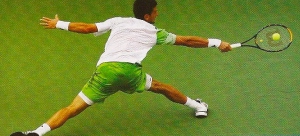
Novak Djokovic
NOVAK DJOKOVIC
Technical
There is virtually no technical weakness in the Djokovic game. This is just reward for a relentless pursuit of excellence even to the extent of seeking expert assistance for such specialist areas as volleying. He has a really high quality serve, the result of a beautiful, smooth, efficient action on both first & second balls & is capable of serving very big on important points.
Tactical
Perhaps the most impressive feature of Novak’s incredible game is his ability to, not only play groundstrokes cross-court & down-the-line, but to be able to change the direction of play almost at will. This allows him to tactically play the direction of his choice when structuring the point, rather than tending to play the percentages & rally predominantly cross-court.
Mental
Possesses a strong sense of self-belief – one gets the distinct impression that Novak is a young man in a hurry to fulfill his expressed dream of becoming the number 1 player in the world
Although the excessive bouncing prior to serving can become a little tedious, there is no questioning his determination to play only when he is completely ready.
Physical
Almost the perfect build for tennis – very strong & capable of exceptional court coverage
Has the ability to produce quality shots from positions of genuine disadvantage – it is not uncommon to see Novak slide on hardcourt, allowing him to achieve near perfect balance under pressure

Venus Wiliams
VENUS WILLIAMS
Technical
There are many stand-out features of the Venus Williams’ game, not the least of which is all-round awesome power. Her first serve is measurably the biggest in the game – the second serve, however, can be a little unreliable as it tends to slide quite regularly to the right-handers’ forehand.
Both groundstrokes are hit off very open stances which requires great strength but allows her to change direction of shot with very little indication to her opponent.
Tactical
It is impossible not to be impressed by Venus’s incredible defensive skills – these often go unnoticed, however, as she is capable of being so aggressive from difficult situations that she can turn almost any defensive situation into offence. Brutal power off both serve & groundstrokes leads to many floated replies which Venus deals with using her explosive trademark drive volleys from mid-court.
Mental
As strange as it seems in the modern game, Venus has been able to mix professional tennis at the highest level with study, fashion & business. When on the court, however, this full lifestyle does not appear to have diminished in any way, pride in her performance & hunger for success.
Physical
Venus must surely be one of the great athletes of all time. She is very tall, very strong with an almost cat-like ability to cover every area of the court.

Maria Sharapova
MARIA SHARAPOVA
Technical
Maria is an extremely aggressive baseliner – both groundstrokes are hit incredibly hard, quite flat & amazingly close to the lines.
Both serves are hit very heavily, frequently setting up weak returns that are often punished with penetrating drive volleys often from very deep in the court.
Perhaps the most characteristic feature is the follow-through on the forehand groundstroke which usually finishes upwards & backwards from the point of contact.
Tactical
There appears to be one game plan – all-out aggression. Although this approach is potentially high risk, in form she can be almost totally domineering. Some would suggest that the trademark “screeching” is tactically motivated.
Mental
Very intense & very focused throughout matches – highly sophisticated, superstitious routines between points especially when serving
Physical
What a great athlete! Very tall & incredibly strong, it is easy to see how she can be so intimidating. Her height is perhaps a slight disadvantage when moving out wide or to short low balls. It is amazing to see the power Maria generates, often off the back foot & with the flourishing follow-through.
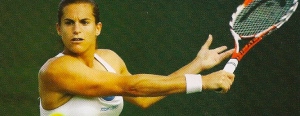
Amelie Mauresmo
AMELIE MAURESMO
Technical
Amelie has such a classical all-court game and, like Justine Henin, the standout feature is her ability to play an amazing range of one-handed backhand groundstrokes. Her topspin variety is played with a heavy backhand grip & a correspondingly quite open stance. She has great feel off the slice backhand as well, which she often uses to approach the net or to set up points with creative dropshots.
Tactical
Not possessing a particularly reliable or penetrating serve, Amelie has developed an amazing range of strokes which allow her to play effectively on all surfaces. She can do just about anything, with her standard baseline game being complimented by many creative options such as serve & volley, slice return & slice approach.
Mental
Great to watch a no-nonsense player who just wants to get on with the job. Sadly, her inability to win at Roland-Garros has probably created an impression, at least within France, of not being mentally strong – so pleasing therefore to note the other grand slam victories.
Physical
An amazingly sculptured athlete who, despite numerous injury problems, continues to play tennis with great artistry & a style of play that requires movement to all areas of the court – maybe the most graceful player in the game.

Serena Williams
SERENA WILLIAMS
Technical
Perhaps Serena is the most complete player in the women’s game. It is hard to find a weakness anywhere. Her first serve is very big & her topspin second serve is of the highest order. Both groundstrokes are extremely penetrating & she possesses a full range of volleys.
Tactical
Everything about Serena’s game is aggressive & dominant. She is constantly attempting to establish an advantage, moving forwards at every opportunity to attack short groundstrokes or to approach the net with a view to finishing the point as quickly as possible.
Mental
Despite the challenges of frequently having to play sister Venus (hard to imagine how difficult this must be), Serena is an amazing “big match” player. Even in recent times, playing almost part-time, she has demonstrated the ability to come into a tournament out of form & to just keep improving match by match – who can forget her Australian Open victory in 2007 (ranked 81st & unseeded)?
Physical
Although not as tall as some of the other leading players of the past decade, Serena is arguably the most powerful athlete on the women’s tour. Despite some injury problems in recent years, she continues to be capable of playing at the highest level in the most intimidating & imposing manner.
SUMMARY
Well, if you have been like me & needed some encouragement to start a process of not just watching but actually learning from the Pros, I hope this helps. One final tip – look past the power aspect of the modern game & focus your attention on technical & tactical soundness which, without exception, would have taken 10 to 15 years of relentless hard work & sacrifice to develop.

Peter Smith
YOUR COACH
South Australian Peter Smith has 40 years experience as a Teaching Professional. Twice voted Australian Tennis Coach of the year, Peter is most widely known as the long term coach of Lleyton Hewitt. He has, however, worked with a long list of other players including former World Number 1 Doubles player and current Australian Davis Cup Captain John Fitzgerald who says, “There is a great argument to say that Peter Smith has had more influence than any coach in Australia in the past two decades in terms of producing world class players”.
Peter is the Head Coach of the Peter Smith Tennis Academy in Adelaide, South Australia
www.petersmithtennis.com / www.ngclubs.com.au
VIRTUALTENNISCOACH.COM
Peter has recently released an instructional DVD “The Development Stage” (also available to download in individual sections or as a complete set) – details can be found at www.virtualtenniscoach.com. This website also contains FREE 10 day coaching course and interviews with a selection of Peter’s former pupils.



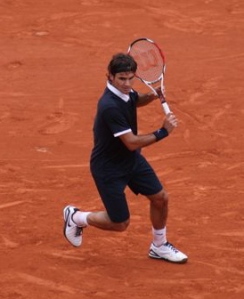
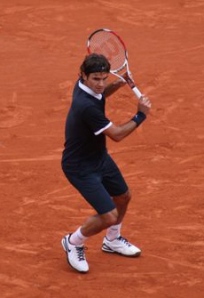
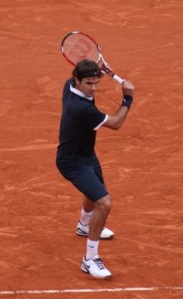 Picture 3
Picture 3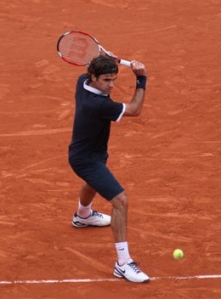 Picture 4
Picture 4 Picture 5
Picture 5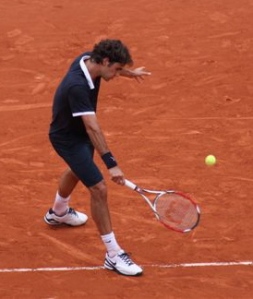 Picture 6
Picture 6  Picture 7
Picture 7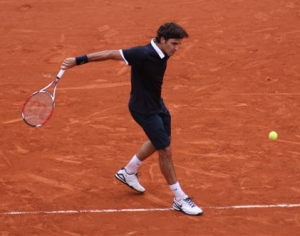 Picture 8
Picture 8